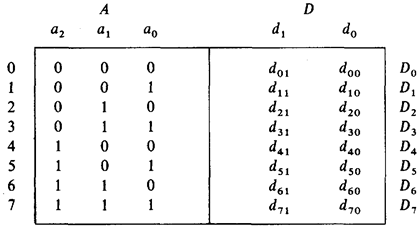
CATEGORIES:
BiologyChemistryConstructionCultureEcologyEconomyElectronicsFinanceGeographyHistoryInformaticsLawMathematicsMechanicsMedicineOtherPedagogyPhilosophyPhysicsPolicyPsychologySociologySportTourism
Memory Devices
3.1 Circuitri of memori element
Semiconductor memories
Semiconductor memories fall into two main categories, as shown in Fig. 3.1: table memories and junction memories. With table memories, an address A is defined in the range
0 £ A £ n = 2N - 1.
The word width of the address is between N = 5 ... 22, depending on the size of memory. Data can be stored at each of the 2N addresses. The data word width is m = 1 ... 16 bits. Figure 3.2 shows an example for N = 3 address bits and m = 2 data bits.

Fig. 3.1 - Categories of commonly used semiconductor memories.
RAM = Random Access Memory PLD = Programmable Logic Device
ROM = Read Only Memory PLA = Programmable Logic Array
M = Mask programmed PAL = Programmable Array Logic
P = Programmable LCA = Logic Cell Array
EP = Erasable and Programmable EEP = Electrically Erasable and Programmable
The memory capacity K = m • n is specified in bits, and also in bytes (K/8) for data word widths of 8 or 16 bits. When using several memory chips, both the address space and the word width can be increased by any amount. This will allow any tables such as truth tables, computer programs or results of measurements (numbers) to be stored.
Function memories store logic functions instead of tables. Each variable of a truth table can be expressed as a logic function. Written in standard product terms, the logic function of variable d0 in Fig. 3.2 becomes

.

Fig. 3.2 - Layout of a table.
Address word width N = 3 bits
Data word width m = 2 bits
If d0 contains no regularity, and the zeros and ones are therefore statistically distributed, we get n/2 - in this case four - non-vanishing product terms. This situation occurs, for instance, when programs are being stored. In this case the implementation of the logic function is more complex than its storage in a table.
However, if a truth table is used as the starting point, extensive simplification is possible for the logic function due to the underlying regularity. One such case is when there are only very few "ones". For example, if in the function d0 only d70 = 1, we only require a single conjunction d0 = a2 a1 d0. Another case is when the logic functions can be simplified using Boolean algebra. For example, if d0 = a1 in Fig.3.2, an extremely simple function is obtained, even though it contains four "ones". In such cases, the use of function memories generally produces much better solutions than storage in a table.
Table memories are subdivided into two distinct categories, namely RAMs and ROMs. RAM is a general designation for read-write memories. The contents of the memory can be both read and written during normal operation. The abbreviation actually stands for Random Access Memory. "Random access" means that any data word within the memory can be accessed at any time, in contrast to shift register memories in which data can only be read from the memory in the same sequence in which they were written into it. As shift register memories are no longer very important, the term RAM has become a generic term for memories with read-write capabilities. This is somewhat misleading, in that ROMs also allow random access to any data word.
ROM is an abbreviation for Read-Only Memory. This designation identifies memory ICs which retain their contents when there is no supply voltage, even without backup batteries. In normal operation, data are only read from such memories but not written into them. Special equipment is normally required for writing the data, the storage procedure being referred to as programming. The sub-categories listed in Fig. 3.1 differ in the type of programming employed, which is described in greater detail below
Date: 2015-01-12; view: 1229
| <== previous page | | | next page ==> |
| Non-inverting Schmitt trigger | | | Mask-type LIC of the ROM |